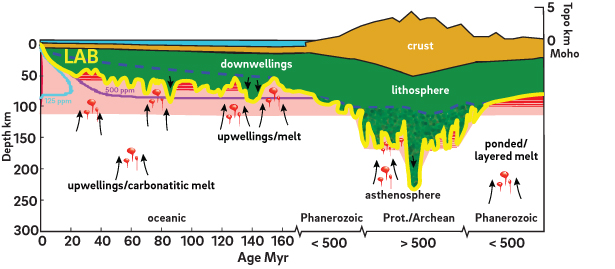IGPP is pleased to invite you to join its Winter 2022 Seminar Series presentation featuring University of Southampton's Catherine Rychert. Dr. Rychert's talk, "A dynamic lithosphere-asthenosphere boundary dictated by variations in melt generation and migration: the PI-LAB experiment with a global perspective" will be available via Zoom on Tuesday, April 5, 2022, starting at 12:00pm. Zoom: https://ucsd.zoom.us/j/93698652588?pwd=Mi9adEN5WFRManBGdFIvUlMvNWNoUT09. Password: dynamic

Time: 12:00 pm, Pacific Time
Location: Zoom
Note: This meeting will be recorded. Please make sure that you are comfortable with this before registering.
Abstract: The lithosphere-asthenosphere boundary (LAB) is central to the theory of plate tectonics. The boundary has implications for our understanding of mantle dynamics, the evolution of the Earth, natural hazards such as earthquakes and volcanoes, and climate change over geologic timescales. Despite its important its exact depth and the factors that dictate the location of the boundary are highly debated. Ocean lithosphere is perhaps the ideal location to study the LAB, given the relative youth and tectonic simplicity of ocean lithosphere in comparison to the continents. However, even beneath the ocean lithosphere reports of the depth and the factors controlling the LAB are variable, perhaps because they are from different methods with different resolutions and in different locations. I present new constraints on the LAB from the PI-LAB (Passive Imaging of the LAB) experiment and EURO-LAB (Experiment to Unearth the Rheological LAB) at the equatorial Mid-Atlantic Ridge using a variety of seismic and magnetotelluric methods. The experiment was designed to investigate young and old oceanic lithosphere using a range of methodologies, techniques and resolutions in one location. The results show that the LAB has a variable character depending on location: simple and with monotonic age progression, undulating, and underlain by a thin melt channel. Partial melt several hundred kilometers off the ridge axis is inferred, as is ridge-related transition zone thinning. Putting the result in the context of previous global observations and interpretations, it suggests a wide variety of scenarios are possible both beneath oceans and continents. The implication is that melt persists over geologic timescales, although its character is dynamic. The result reconciles seemingly discrepant reports of the character of the LAB and the locations of partial melt in terms of geometry, location, pervasiveness, and volume from a variety of studies. It also suggests melt dynamics are important in dictating plate tectonics and mantle convection.
